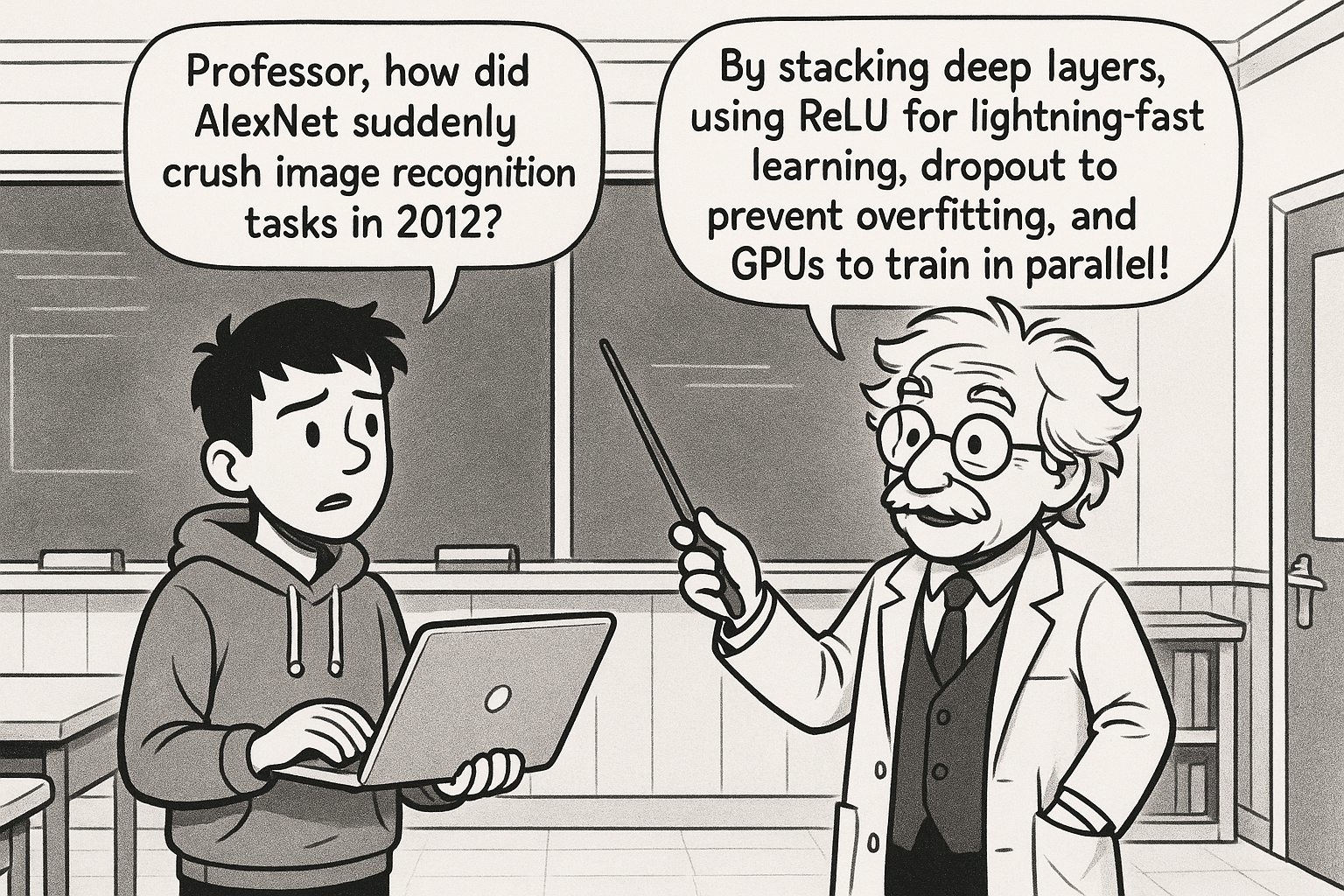Introduction
In 2012, Alex Krizhevsky, Ilya Sutskever, and Geoffrey Hinton published "ImageNet Classification with Deep Convolutional Neural Networks" introducing AlexNet to the world. This research paper changed the entire landscape of computer vision and artificial intelligence. AlexNet won the ImageNet Large Scale Visual Recognition Challenge (ILSVRC-2012) competition with a stunning top-5 error rate of just 15.3%, compared to the second-place entry's 26.2%. This victory marked the beginning of the deep learning revolution and proved that neural networks could achieve superhuman performance in image recognition tasks.
"Deep learning transformed from academic curiosity to industry revolution when GPUs met massive datasets and clever architectures."
Core Ideas
AlexNet's architecture was revolutionary for its time, featuring eight layers that transformed how machines could understand images. The network consisted of five convolutional layers for feature extraction, followed by three fully connected layers for classification. With 60 million parameters and 650,000 neurons, it was significantly deeper than previous models, enabling it to learn complex visual patterns from the massive ImageNet dataset containing 1.2 million high-resolution images across 1,000 different categories.
The team introduced several key innovations that made deep learning practical and effective. First, they used Rectified Linear Unit (ReLU) activation functions instead of traditional sigmoid or tanh functions. ReLU solved the vanishing gradient problem that plagued deep networks, accelerating training by approximately six times while maintaining accuracy. The simple mathematical operation of ReLU (outputting the input if positive, otherwise zero) made computation faster and more efficient.
Another crucial innovation was the implementation of dropout regularisation. During training, neurons were randomly "dropped out" with a probability of 0.5, meaning they wouldn't contribute to forward or backward propagation. This technique prevented overfitting by forcing the network to learn more robust features rather than memorising specific patterns. While dropout doubled the training time, it was essential for generalisation on unseen data.
The researchers also employed data augmentation techniques to artificially expand their training dataset. They used image translations, horizontal reflections, and altered RGB channel intensities to create variations of existing images. This approach increased the effective dataset size by a factor of 2048, helping the model generalise better to new images.
Most importantly, AlexNet was the first major deep learning model to leverage Graphics Processing Units (GPUs) for training. The network was actually split across two Nvidia GTX 580 GPUs (3GB each) due to memory constraints. This parallel processing approach reduced training time from months to just five to six days, making deep learning practically feasible for large-scale datasets.
Breaking Down the Key Concepts
Think of AlexNet as a sophisticated pattern recognition system that learns to identify images layer by layer. Imagine you're teaching a child to recognise different animals. Initially, they might notice basic features like edges and colours. Gradually, they learn to combine these simple features to recognise more complex patterns like fur textures, eye shapes, and body proportions. Finally, they can identify the complete animal.
AlexNet works similarly but with mathematical precision. The first few convolutional layers detect simple features like edges and textures. Each subsequent layer combines these simpler features to recognise increasingly complex patterns. The final layers can identify specific objects like cats, dogs, or cars.
The ReLU activation function acts like a gatekeeper that only allows positive signals to pass through, eliminating negative values. This simple rule prevents the network from getting confused by conflicting signals and speeds up learning significantly.
Dropout is like randomly blindfolding some students during an exam preparation. When some neurons are temporarily disabled, the remaining ones must work harder and learn more general skills rather than relying on specific combinations. This makes the entire network more robust and better at handling new, unseen images.
The GPU acceleration is comparable to having a team of mathematicians working in parallel rather than one person doing all calculations sequentially. GPUs excel at performing thousands of simple mathematical operations simultaneously, which is exactly what neural networks require during training.

Results and Significance
AlexNet's victory in the ImageNet competition was decisive and transformative. The 10.8 percentage point improvement over the second-place entry wasn't just a marginal gain – it represented a paradigm shift in computer vision. This breakthrough opened up entirely new possibilities in AI applications, from medical imaging to autonomous vehicles.
The paper demonstrated that depth matters significantly in neural networks. Previous models typically had only 2-3 layers, while AlexNet's 8-layer architecture could capture much more complex visual representations. This insight led to the development of even deeper networks like VGGNet, ResNet, and modern architectures used in today's AI applications.
AlexNet's success validated the importance of three critical factors: large-scale datasets, powerful computational resources, and innovative architectural design. The ImageNet dataset provided the diverse, high-quality training data necessary for learning robust visual representations. GPU acceleration made training feasible within reasonable timeframes. The architectural innovations solved long-standing problems in deep learning.
For the broader AI community, AlexNet's triumph marked the end of hand-engineered feature extraction in computer vision. Previously, researchers manually designed algorithms to detect specific features like edges or corners. AlexNet proved that neural networks could automatically learn better features directly from data, leading to superior performance across various visual tasks.
The model's influence extended far beyond computer vision. Its success convinced researchers and industry practitioners that deep learning was the future of AI. This led to massive investments in GPU infrastructure, the development of deep learning frameworks like TensorFlow and PyTorch, and the application of similar techniques to speech recognition, natural language processing, and other AI domains.
Read the full paper here - https://papers.nips.cc/paper_files/paper/2012/hash/c399862d3b9d6b76c8436e924a68c45b-Abstract.html